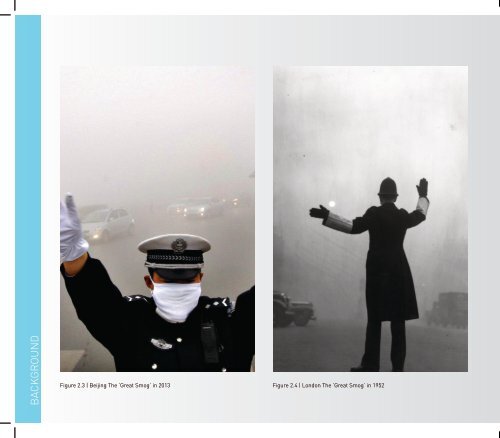Thesis Book
Create successful ePaper yourself
Turn your PDF publications into a flip-book with our unique Google optimized e-Paper software.
11<br />
WESTERN APPROACH<br />
BACKGROUND<br />
Figure 2.3 | Beijing The ‘Great Smog’ in 2013 Figure 2.4 | London The ‘Great Smog’ in 1952<br />
China is not the only country that has<br />
experienced deadly human-induced<br />
pollution levels. The “Great Smog”<br />
happened in London in 1951, killing<br />
4,000 people in 4 days, and the causes<br />
of London’s smog were similar to those<br />
in Shijiazhuang (John, Shulenberger &<br />
Endlicher 2008). Like China, London’s<br />
economic performance at the time was<br />
strong and the city was experiencing<br />
rapid growth, but smog was the<br />
unpleasant cost of this growth. As the<br />
main energy source, coal-burning fires<br />
resulted in significant air pollution across<br />
the city, and most people at that time<br />
did not understand the importance of a<br />
healthy environment. However, London<br />
learned important lessons from this<br />
health disaster. After the London smog,<br />
urban citizens changed their heating<br />
system from individual to collective,<br />
installing filter systems. As well, people<br />
strived to look for more green energy<br />
to substitute for coal, and air pollution<br />
became an important part of education.<br />
In the 20th century, London’s air<br />
pollution becomes serious again. There<br />
is a researcher who followed children<br />
in central London schools, and found<br />
that their lung capacity was reduced<br />
significantly by the age of eight or nine<br />
(Vidal 2013). The research also came out<br />
with a startling conclusion that people<br />
will have smaller lungs forever when<br />
they live in a polluted area. The point<br />
is, the lung volume problem will affect<br />
people’s bodies in the future and that is<br />
why people die of lung disease later on<br />
(Vidal 2013). Today, London air pollution<br />
is linked to the death of 4,300 people<br />
per year, and air pollution is the root of<br />
health problems which include heart and<br />
lung diseases, cancers and respiratory<br />
problems (Fuller 2013). London authority<br />
launched the ‘Low Emission Zone’ from<br />
2008, which is a traffic pollution charge<br />
scheme with the aim of reducing the car<br />
pollution in London. The ‘Low Emission<br />
Zone’ only charges vehicles that do not<br />
conform to higher emission standards,<br />
and others can enter the controlled zone<br />
for free (BBC 2007).<br />
Carpooling is a simple way for<br />
individuals to save money and go<br />
where they want to go. It also reduces<br />
congestion and conserves energy along<br />
the way. ‘Carpooling’ is sharing a car with<br />
more than one person; more people using<br />
one vehicle reduces each person’s travel<br />
costs and the stress of driving. Carpooling<br />
has become more popular in western<br />
countries because of the gas shortage,<br />
resulting from the 1973 oil crisis (Amey<br />
& Oliphant 2010). Today, carpooling is a<br />
great way to solve traffic congestion and<br />
carbon emission problems.<br />
China needs to understand exactly<br />
what was done in London at the time and<br />
connect to contemporary London. London<br />
clears the smog but leaves pollutants<br />
on a level that continue to erode the<br />
health of the population. China, in dealing<br />
with air pollution problems, should be<br />
more cautious and consider long-term<br />
implications.





